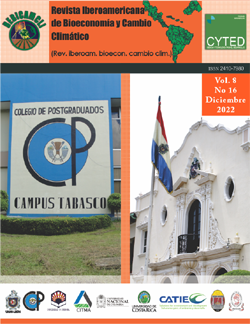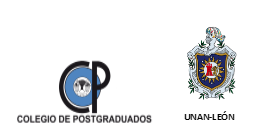Bioconomic devepment and mangroves in Latin America
DOI:
https://doi.org/10.5377/ribcc.v8i16.15162Keywords:
mangroves, Latin America, development, Biodiversity, BioeconomyAbstract
The demand for goods and services increases as a function of population growth, which leads to the overexploitation of natural resources and the imbalance of natural ecosystems. At the global level, treaties, conventions and agreements have been made in order to ensure the management of natural resources, promoting actions that reduce global warming and guarantee the protection of biodiversity. Nevertheless; The acceptance of these treaties, conventions and agreements has not had the expected repercussions, nor has its implementation been of greater importance. Therefore, this work had the objective of collecting information related to the main commercial activities that are causing mangrove deforestation in Latin America. Its importance lies in the fact that it favors the development of aquatic species with nutritional and commercial value, sustaining the bioeconomy of coastal communities through fishing, the production of wood and charcoal, carbon storage, the cushioning effect of hurricanes and storms, control of coastal erosion and saline intrusion, they also function as biological filters. Globally, it is estimated that mangroves provide US$1.6 billion per year in ecosystem services and livelihoods. However, from 1980 to 2005 in Latin America, 807,030 ha of mangroves were lost. The main causes are attributed to agriculture in the coastal plain, urban sprawl, oil industries, road and bridge construction, and conversion to shrimp farming industries.
Downloads
442
HTML (Español (España)) 0
References
Alongi, D. M. (2002). Present state and future of the world’s mangrove forests. Environmental Conservation, 29(3), 331–349. https://doi.org/10.1017/s0376892902000231
Aye, W.N.; Wen, Y.; Marin, K.; Thapa, S.; Tun, A.W. (2019) Contribution of Mangrove Forest to the Livelihood of Local Communities in Ayeyar waddy Region, Myanmar. Forests, 10 (5) 414. https://doi.org/10.3390/f10050414
Baba, S., Chan, H. T., & Aksornkoae, S. (2013). Useful Products from Mangrove and other Coastal Plants. ISME Mangrove Educational Book Series No. 3. International Society for Mangrove Ecosystems (ISME). En and International Tropical Timber Organization (ITTO).
Blanco, J. F., Estrada, E. A., Ortiz, L. F., & Urrego, L. E. (2012). Ecosystem-wide impacts of deforestation in mangroves: The Urabá Gulf (Colombian Caribbean) case study. ISRN Ecology, 2012, 1–14. https://doi.org/10.5402/2012/958709
Boyd, C. E., Davis, R. P., Wilson, A. G., Marcillo, F., Brian, S., & McNevin, A. A. (2021). Resource use in whiteleg shrimp Litopenaeus vannamei farming in Ecuador. Journal of the World Aquaculture Society, 52(4), 772–788. https://doi.org/10.1111/jwas.12818
Bishawjit M., Rupkatha P., Jude N. K, Bangkim B, Alexander E. H., Safiqul I., Saleemul Huq, Joachim V. 2021. Livelihoods dependence on mangrove ecosystems: Empirical evidence from the Sundarbans. Elsevier. Gemany. DOI: http://doi.org/10.1016/j.crsust.2021.100077
Broadhead, J. S. (2011). Regional fisheries livelihoods programme for south and southeast Asia (rflp). Fao.org. https://www.fao.org/3/ar463e/ar463e.pdf
Cano-Otalvaro, J. L., Murillo García, O. E., Cantera-Kintz, J. R., & Gil-Agudelo, D. L. (2012). Diferenciación morfológica de las especies de Piangua Anadara Tuberculosa y Anadara Similis (Arcidae) en diferentes bosques de manglar a lo largo de la costa pacífica colombiana mediante morfometría geométrica. Bol. Invest. Mar. Cost, 41(1), 47–60.
Capote, R. P., & Menéndez, L. (2006). Ecosistema de manglar en el Archipiélago cubano. Estudios y experiencias enfocados a su gestión (Vol. 320). Academia La Habana.
Carrere R., Y Fonsca H. (2002) Manglares: sustento local versus ganancia empresarial. Movimeinto mundialpor los bosuqes tropicales. ISBN 9974760895. 126 p
Castillo-Elías B., Gervacio-Jiménez., H., Vences-Martínez J.A. 2021. Diagnóstico de áreas degradadas de manglar y propuestas de restauración ecológica en el estado de Guerrero, México. Revista Iberoamericana de Ciencias agropecuarias. Vol. 10, Núm. 20 Julio – diciembre 2021. DOI: https://doi.org/10.23913/ciba.v10i20.108
Fonseca-Moreno, E. (2010). Industria del camarón: su responsabilidad en la desaparición de los manglares y la contaminación acuática. REDVET, Revista electrónica de Veterinaria, 11, 1–20.
Food and Agriculture Organization of the United Nations. (2007). The World’s Mangroves 1980-2005.
Food & Agriculture Organization of the United Nations (FAO).
Foroughbakhch, P. R., Cespedes, C. A., Alvarado, V. M. A., Núñez, G. A., & Badii, M. H. (2004). Aspectos ecológicos de los manglares y su potencial como fitorremediadores en el Golfo de México. Ciencia Universidad Autónoma de Nuevo León, 203–208.
Ghosh, D. (2011). Mangroves The Most Fragile Forest Ecosystem. Journal of Magnetic Resonance, 16(1), 47–60.
Ghosh, N. (2019). Ecosystem Services of Mangroves and their Valuation. Faunal Diversity of Indian Mangroves, 1–19.
Gilman, E., Van Lavieren, H., Ellison, J., Jungblut, V., Wilson, L., Areki, F., Brighouse, G., Bungitak, J., Dus, E., Henry, M., Sauni, I., Kilman, M., Matthews, E., Teariki-Ruatu, N., Tukia, S., & Yuknavage, K. (2006). Pacific Island Mangroves in a Changing Climate and Rising Sea. United Nations Enviroment Programment Regional Seas Reports and Studies, 70(179).
Giri, C., Ochieng, E., Tieszen, L. L., Zhu, Z., Singh, A., Loveland, T., Masek, J., & Duke, N. (2010). Status and distribution of mangrove forests of the world using earth observation satellite data: Status and distributions of global mangroves. Global Ecology and Biogeography: A Journal of Macroecology, 20(1), 154–159. https://doi.org/10.1111/j.1466-8238.2010.00584.x
Hernández-Cornejo, R., Koedam, N., Luna, A., Troell, M., & Dahdouh-Guebas, F. (2005). Remote Sensing and Ethnobotanical Assessment of the Mangrove Forest Changes in the Navachiste-San Ignacio-Macapule Lagoon Complex, Sinaloa, México. Ecology and Society, 10(1), 1–19.
Hirales-Cota, M., Espinoza-Avalos, J., Schmook, B., Ruiz-Luna Y, A., & Ramos-Reyes, R. (2010). Agentes de deforestación de manglar en Mahahual-Xcalak, Quintana Roo, sureste de México. Ciencias marinas, 36(2), 147–159.
Instituto Nacional de Ecología. (2005). Evaluación preliminar de las tasas de pérdida de superficie de manglar en México. Org.mx. https://agua.org.mx/wp-content/uploads/2010/11/233_informe_manglar.pdf
Instituto Nacional de Recursos Naturales. (2007). Plan Maestro 2007 - 2011. Santuario Nacional Los Manglares de Tumbes. SINIA | Sistema Nacional de Información Ambiental. https://sinia.minam.gob.pe/documentos/plan-maestro-2007-2011-santuario-nacional-manglares-tumbes
Jiménez, J. A. (1999). Ambiente, Distribución y Características Estructurales en los Manglares del Pacífico de Centro América: Contrastes Climáticos. In: A. Yáñez–Arancibia y A. L. Lara–Domínguez (eds.). Ecosistemas de Manglar en América Tropical. Docplayer.Es. https://docplayer.es/8810953-Ambiente-distribucion-y-caracteristicas-estructurales-en-los-manglares-del-pacifico-de-centro-america-contrastes-climaticos.html
Kathiresan, K., & Bingham, B. L. (2001). Biology of mangroves and mangrove Ecosystems. En Advances in Marine Biology (pp. 81–251). Elsevier.
Lang’at, J. K. S., & Kairo, J. G. (2008). Conservation and management of mangrove forests in Kenya. https://aquadocs.org/handle/1834/6989
López, P. J., & Ezcurra, E. (2002). Los manglares de México: una revisión. Maderas y bosques, 8(1), 27–32.
Magaña Rueda, V. O. (2011). Cambio climático: El reto del siglo. Investigación ambiental Ciencia y política pública, 3(1), 63–67.
Malik, A., Fensholt, R., & Mertz, O. (2015). Economic valuation of mangroves for comparison with commercial aquaculture in south Sulawesi, Indonesia. Forests, 6(12), 3028–3044. https://doi.org/10.3390/f6093028
Miththapala, S. (2008). Coastal Ecosystems Series 2:36 p. Colombo. Sri Lanka: Ecosystems and Livelihoods Group Asia International Union for Conservatión of Nature and Natural Resources. Katuwana Road.
Murdiyarso, D., Donato, D., Boone Kauffman, J., Kurnianto, S., Stidham, M., & Kanninen, M. (2009). Carbon storage in mangrove and peatland ecosystems: A preliminary account from plots in Indonesia. Working Paper 48. Bogor Banat, Indonesia: Center for International Forestry Research. 35 p., 1–35. https://www.fs.usda.gov/research/treesearch/37148
Musello, C., Álvarez, M., & Flores, L. (2009). Crecimiento de Anadara similis (C. B. Adams, 1852) en la Reserva Ecológica de Manglares Cayapas-Mataje, REMACAM: Una aproximación basada en tallas. Artículo de tesis de grado. 1–7.
Ong, J. E. (2002). The Hidden Costs of Mangrove Services: Use of Mangroves for Shrimp Aquaculture. International Science Roundtable for the Media.
Ong, J. E., & Gong, W. K. (2013). Structure, Function and Management of Mangrove Ecosystems. ISME Mangrove Educational Book Series No. 2. International Society for Mangrove Ecosystems (ISME), Okinawa, Japan, and International Tropical Timber Organization (ITTO) (Vol. 81).
Pennings, S. C., Glazner, R. M., Hughes, Z. J., Kominoski, J. S., & Armitage, A. R. (2021). Effects of mangrove cover on coastal erosion during a hurricane in Texas, USA. Ecology, 102(4). https://doi.org/10.1002/ecy.3309
PNUMA. (2010). Estado de la biodiversidad en América Latina y el Caribe FUENTE: State of biodiversity in latín América and the caribbean: a review of progress towards the aichi biodiversity targets ALC contiene alrededor de 60% de la biodiversidad del planeta. Pnuma.org. http://www.pnuma.org/images/infografia/EstadodeBiodiversidad-LAC.pdf
Polidoro, B. A., Carpenter, K. E., Collins, L., Duke, N. C., Ellison, A. M., Ellison, J. C., Farnsworth, E. J., Fernando, E. S., Kathiresan, K., Koedam, N. E., Livingstone, S. R., Miyagi, T., Moore, G. E., Ngoc Nam, V., Ong, J. E., Primavera, J. H., Salmo, S. G., Sanciangco, J. C., Sukardjo, S., … Yong, J. W. H. (2010). The loss of species: mangrove extinction risk and geographic areas of global concern. PloS One, 5(4), e10095. https://doi.org/10.1371/journal.pone.0010095
Rog, S. M., Clarke, R. H., & Cook, C. N. (2017). More than marine: revealing the critical importance of mangrove ecosystems for terrestrial vertebrates. Diversity & Distributions, 23(2), 221–230. https://doi.org/10.1111/ddi.12514
Romero, S. N. (2014). Neoliberalismo e industria camaronera en Ecuador. Letras Verdes. Revista Latinoamericana de estudios Socioambientales. 55–78.
Smith, J., Schellinhuber, H., & Mirza, M. (2001). Vulnerability to climate change and reasons for concern: a synthesis. En J. Mccarthy, O. Canziani, N. Leary, D. Dokken, & K. White (Eds.), Climate Change 2001: Impacts, Adaptation, and Vulnerability. Published for the Intergovernmental Panel on Climate Change (Vol. 942). Cambridge University Press.
Sol Sánchez, Á., Melchor, G. I. H., & Zaldívar Crúz, J. M. (2020). Function of the medicinal plants of the mangroves in a society of high marginalization in Tabasco, Mexico. En Bioeconomy for Sustainable Development (pp. 321–332). Springer Singapore.
Spalding, Mark D., and Leal, Maricé. (2021). The State of the World’s Mangroves 2021. Global Mangrove Alliance. Mangrovealliance.org. https://www.mangrovealliance.org/wp-content/uploads/2021/07/The-State-of-the-Worlds-Mangroves-2021-FINAL.pdf
Velázquez-Salazar S., Rodríguez-Zúñiga M.T., Alcántara-Maya J.A., Villeda-Chávez E., Valderrama-Landeros L., Troche-Souza C., Vázquez-Balderas B., Pérez-Espinosa I., Cruz-López M. I., Ressl R., De la Borbolla D. V. G., Paz O., Aguilar-Sierra V., Hruby F. y Muñoa-Coutiño J. H. (2021). Manglares de México. Actualización y análisis de los datos 2020. Comisión Nacional para el Conocimiento y Uso de la Biodiversidad. México CDMX. Pp. 168
Vinoth, R., Kumaravel, S., & Ranganathan, R. (2019). Therapeutic and Traditional Uses of Mangrove Plants. Journal of Drug Delivery & Therapeutics, 9(4-s), 849–854.
Zaragoza, R., & Peters y E. Vega., E. (2005). Evaluación de las tasas de pérdida de manglar mediante la comparación de polígonos en 1976 y 2000. In: INE (Ed). Evaluación preliminar de las tasas de pérdida de superficie de manglar en México. INE, 21.
Published
How to Cite
Issue
Section
Categories
License
Copyright (c) 2022 Rev. iberoam. bioecon. cambio clim.

This work is licensed under a Creative Commons Attribution-NonCommercial-ShareAlike 4.0 International License.
Copyright © Rev. iberoam. bioecon. climate change (Graduate School and UNAN-León, School of Agricultural and Veterinary Sciences / Department of Agroecology / Center for Research in Bioeconomy and Climate Cahnge (CRByCC).







